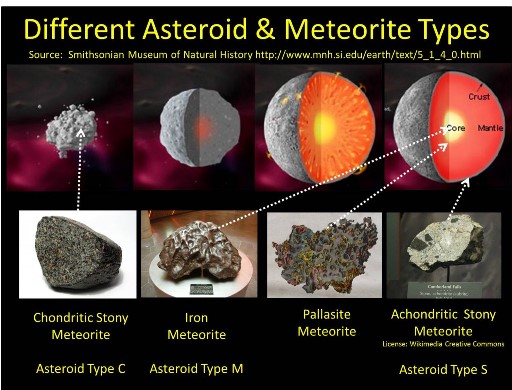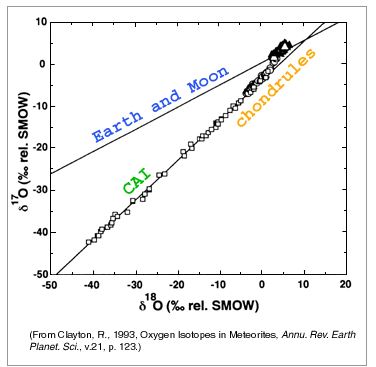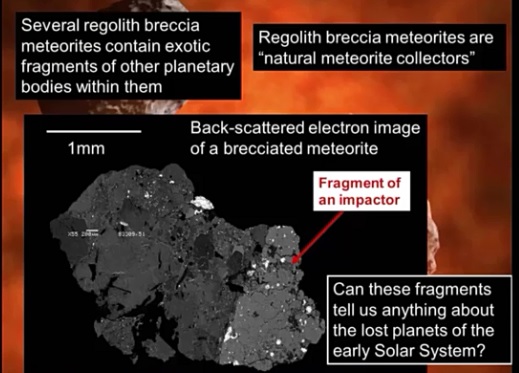Introduction
Our November talk was “Lost Worlds of the Solar System” by Professor Hilary Downes of Birkbeck College and was a challenging combination of geology and astronomy. Her talk began with an overview of the early solar system before focussing on her work on the evidence from meteorites containing remnants of “lost worlds”. I will get on to trying to describe her results but first I’m going to start by giving some general information about meteorites.
The idea that the early stages of the inner planets formation was by accretion of rocky material into planetisimals , then into planet embryos and finally our planets is familiar. What is perhaps less familiar is the concept that while collisions could build worlds, they could also destroy these protoplanets. You could say that Earth was lucky to survive its collision with Theta which led to the creation of our Moon. One consequence of all this colliding and destruction was the creation of fragments of various sizes and compositions which fall on Earth as meteorites.
About meteorites
Meteorites fall into three broad categories – stony meteorites, iron rich meteorites and iron-stony meteorites. Stony meteorites are by far the most common. They may be asteroids knocked off course or parts of asteroids or the crust of a destroyed protoplanet. Iron-rich meteorites come from the core of destroyed protoplanets. Iron-stony meteorites probably formed in the boundary between the mantle and core. (The rocks of the mantle are thought to disintegrate and are not preserved as meteorites.) This implies that the destroyed protoplanets were substantial enough to have the crust – mantle – core structure ; this was news to me. Perhaps it shouldn’t have been.

Another concept which was entirely new to me was the existence of pre-solar grains embedded in a meteorite. A meteorite will not be a homogeneous material as the parent material was formed by collisions and accretion. Rather it will include a variety of different particles embedded in it. In amongst these can be small, very small grains which have been analysed to be up to 7 billion years old, making them significantly older than our Solar System. When I say very small, I mean microscopic with the particles being only microns in size.
Analysing meteorites
The methods for analysing the different grains of a rocky meteorite are based on isotopic analysis. In Professor Downes work, the relative abundance of three oxygen isotopes was used. The isotopes are the most abundant O-16, the two others being O-17 and O-18. The information on the analysis is presented on an oxygen isotope plot. This shows the ratio of O-17/O-16 on one axis and the O-18/O-16 on the other. I have not really got my head round this at all; the only important point is that similar types of meteorites fall on a straight line on plots like this. The image below gives you an idea of what these plots look like. It is for calcium-aluminium rich inclusions and chondrules (round grains) in stony meteorites, not the meteorites described by Professor Downes.

(Isotopic analysis was also used to date the pre-solar grains mentioned above, though in this case it was the relative abundance of Xenon isotopes which was measured. This did not match that of our Sun but was more typical of the relative abundance in a red giant)
Professor Downes work
The heart of the talk was about the analysis of two meteorite samples, firstly of a very small meteorite about 3mm across (or maybe it was a fragment from a larger one, I’m not too sure). It was clear that the sample was made of two distinct rock types, indicating it had been formed by a collision between two different rocky bodies. There were also tiny grains of a different rock embedded in one of them; this meteorite had a long history of collisions!

The analysis concentrated on one of these white grains in the image above. We were shown oxygen isotope graphs with lines for known types of meteorite. The key fact was that the grain in question did not lie on any of the lines. Definitely something new!
The second meteorite described had been found in Antarctica. This included a small grain which was shown by chemical analysis to be a mixture of quartz and feldspar with the typical interlocking of the phases of granite. Granite is quite common on Earth but it is very rare now elsewhere in the solar system, so it was concluded that this too must have originated from an earlier body.
This work adds to that on “ungrouped” meteorites. The description “ungrouped” means the meteorite cannot be assigned to any of the known categories. Of the many thousands of meteorites which have been fully categorised, there are about 200 which are ungrouped and are inferred to come from destroyed protoplanets. All of this adds to the jigsaw puzzle of research about the origins of the Solar System and the building of the planets – in other words, those protoplanets which survived.
By the end of the talk, I was taken by how painstaking the research was; how valuable tiny pieces of evidence were; how much information they can provide. This has been one of the more difficult talks to write about and I hope I have done it some justice. Please comment if I need to make any corrections.
This talk was also given in 2016 Science Week and is available on YouTube version of talk.
Talk given by Hilary Downes of Birkbeck College
Post written by Katherine Rusbridge
Nov 2020
